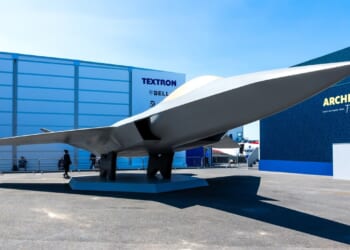In June, the US Air Force launched an unprecedented attack against Iran’s nuclear weapons program.
During “Operation Midnight Hammer,” several B-2 Spirit stealth strategic bombers flew from the continental United States, secretly entered Iran, dropped the biggest non-nuclear bombs in the world on its nuclear sites, and escaped. In total, the planes flew for more than 18 hours. A few hours after the American strikes, Israel and Iran agreed to a ceasefire—setting the Iranian nuclear weapons program back for months, if not years.
However, more sustained bombing operations might be required to prevail in a war with a near-peer adversary like China or Russia, according to senior Air Force officers.
In a large-scale near-peer conflict, the ability to field many strategic bombers can be what tilts the scales in favor of the US military. For decades, the US Air Force has relied on limited precision strikes to achieve its goals. But a non-nuclear conflict with China or Russia would require large numbers of aircraft to sustain bombing operations for long periods of time.
“I can never assume that any single strike is going to be enough,” Air Force Major General Jason Armagost, the commander of the 8th Air Force, said on a webinar hosted by the Air & Space Forces Association’s Mitchell Institute for Aerospace Studies last week. “We have to be ready and postured and capable of generating, very quickly. . . across the platforms, to bring that long range, global capability, [and] mass to problem sets.”
The US military fields the largest and most advanced bomber fleet in the world. China, however, is modernizing and expanding its strategic bomber forces. And in spite of the protracted conflict in Ukraine and the concomitant losses, Russia also possesses a credible strategic bomber fleet.
In his remarks, Armagost highlighted the “unbelievable deterrent value” of a large deep-penetration bomber capability. The US Air Force’s current strategic bomber fleet consists of the B-1 Lancer, B-2 Spirit, and B-52 Stratofortress. In the future, however, the service is aiming for a joint fleet consisting of the B-21 Raider sixth-generation stealth bomber, which is undergoing flight testing, and the B-52. The Pentagon is aiming at as many as 220 bombers.
“We have to provide as many options as we can to the decision makers. 20 years from now, 10 years from now, we don’t know what those national security challenges are going to be,” Armagost added. “What you’re ultimately trying to do. . . is create options. You look at cost per kill, you look at strike efficiency. How do you get the most with the least, or with the most diverse options?”
The Air Force officer highlighted that cutting-edge aircraft require cutting-edge weapons to be the most effective on the battlefield. This, in turn, requires a consistent and predictable funding cycle—helping to create munitions that can overcome adversary air defenses.
America’s aerial strength lies in both its numbers and its advanced technology—a winning formula that no other nation has thus far managed to replicate.
About the Author: Stavros Atlamazoglou
Stavros Atlamazoglou is a seasoned defense journalist specializing in special operations and a Hellenic Army veteran (national service with the 575th Marine Battalion and Army HQ). He holds a BA from the Johns Hopkins University and an MA from the Johns Hopkins’ School of Advanced International Studies (SAIS). His work has been featured in Business Insider, Sandboxx, and SOFREP.
Image: Wikimedia Commons.















